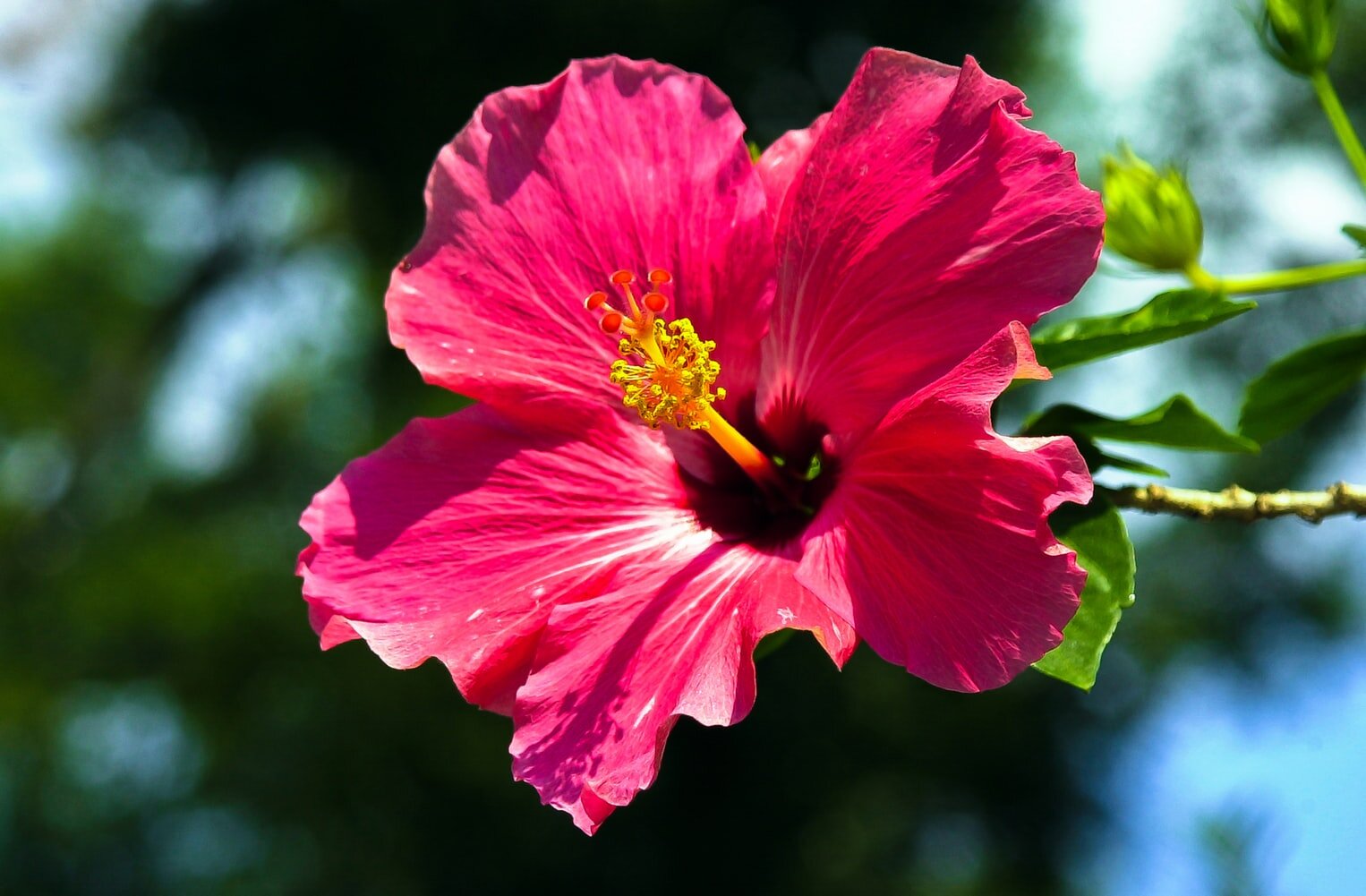Bringing in the Tropics
In this article we introduce you to growing tropical plants. If you want to learn how to overwinter subtropical plants check out our article here.
Tropical Hibiscus
This tropical plant boasts dramatic, trumpet-shaped blooms growing up to 6 inches in diameter with protruding stamens. Native to Asia, tropical hibiscus plants produce flowers constantly, but each blossom only lasts one day. In our climate tropical Hibiscus are ideal on a porch in a large container, and overwintered indoors.
Hibiscus prefer filtered sunlight, if you place hibiscus in direct sunlight, the leaves will scorch. They do not do well in heavy shade or in wind. Use a well-drained potting mix to help avoid the risk of root-rot. Water Hibiscus regularly, as these plants will only produce flowers if given enough water. If you are giving it water daily and it is still not producing flowers try moving it to a sunnier location. To keep your hibiscus blooming, you should pinch off blossoms after they fade.
Pictured: Bougainvillea
Bougainvillea
Bougainvillea is a tropical vine that flowers in shades of orange, pink, purple, red, white and yellow. The flowers of bougainvillea are actually showy paper-like structures are a modified leaf called a bract. These bracts hide the actual flowers inside, which are small and trumpet-shaped in whites and yellows. The showy bracts are typically found on new growth, with the showiest display following their winter dormancy. Be sure to give this vine room to spread as it can grow vigorously in the right location.
Bougainvillea are happy to live outside in our climate after the risk of frost has passed, usually in May. The best placement for your bougainvillea is a reasonably protected spot on a balcony or terrace. Keeping it on the dry side in the early spring (May and June) will stress the plant and actually make it produce more flowers for the summer! Once the hot summer weather arrives, the bougainvillea will need to be watered almost every day. Ensure excess water can drain away. To keep the blooms coming, fertilizer once per week with a fertilizer that encourages blooms, like Powerbloom.
Citrus
Citrus varieties will grow year-round if kept in the right conditions. They all bear edible fruit and have glossy, evergreen leaves and delicious-smelling flowers (the scent is so good!).
Citrus love to spend the summers outside in a protected spot. Acclimate the tree to full sunlight gradually, putting it in a shady area for a few days first. Once a month, feed the citrus with a good multipurpose fertilizer that contains zinc, iron, and manganese. Ease of on the fertilizer through the winter as this encourages too much new growth.
If you need to add soil to your tree container, always use a sterile mix with perlite. Only add soil to the same line on the trunk. Leave at least an inch at the top of the pot for watering room. These trees like regular watering; usually every week to 10 days is enough. When the soil is no longer damp, go ahead and water. Be thorough, but don’t drench the soil. Citrus don’t like wet feet. A western or southern exposure is the best.
Citrus love humidity. If your living space is dry, especially in winter, mist them frequently. It is also a good idea to put them in a large tray with pebbles and add water to the top of the pebbles. Do not stand your tree in front of a drafty vent.
Your tree will produce an abundance of blossoms just like any other fruit tree. Not all of these blossoms will produce fruit. You can encourage pollination by taking a soft small paintbrush and brushing the stamens of open blossoms from blossom to blossom. There aren’t often enough bees in the house to pollinate!
As for pests, spray your tree with horticultural oil, or dormant oil following package directions. Your most likely pest will be spider mites, and the oil will smother them.
Pictured: Mandevilla
Mandevilla
This classic tropical vine is native to Brazil. It has glossy leaves and striking trumpet shaped flowers in colours of pink, red, and white, and even apricot. It is generally grown as a vine but can also be pruned to maintain a shrub-like upright shape. Flowers are pleasently fragrant. Ideal as a patio plant, mandevilla typically grows as a vine but there are some newer shrub forms.
This plant loves light and good drainage. Wait until it starts to dry out before you water. Fertilize your mandevilla every other week with a liquid fertilizer when it is actively growing. Unlike many tropical plants, mandevilla does not like to be pot bound so give it room to grow.
Pictured: Calla lily
Calla Lily
Calla lilies are easy to grow and are a great way to add a pop of colour to shadier containers and planters. The distinctive flowers come in many beautiful colors, including classic white, yellow, orange, pink, rose, lavender and our personal favourite, dark maroon.
Plants are 1-2’ tall and have smooth, glossy foliage that sometimes has pretty white speckles. Calla lily foliage looks neat and attractive all season long, both before and after the flowers bloom. Whether in the garden or in a vase, fresh calla lilies are always impressive. Plants love moisture so be sure to water regularly in hot weather.
Pictured: Canna Lily
Canna Lily
Related to banana and gingers, this tropical looking plant has huge paddle-shaped leaves in gorgeous colours of red, orange and bronze. The flowers are similar in shape to an iris and blooms in colours of red, yellow and orange. Growing up to 5-6 feet tall canna lillies can make a great statement plant in containers.
Cannas grow best in moist soil, fertile soil and full sun. Deadheading promotes increased flowering, but be sure to snip off only spent flowers, as several flowers can grow on a single stem. Once all flowers have bloomed on a stem, cut the flower stem down to the foliage.
Pictured: Musa bajoo
Banana
Hardy banana (Musa bajoo) is the hardiest banana species and is hardy in our climate, though can die to the ground in harsh winters. This isn’t a problem because botanically speaking bananas are perennials (we do recommend some winter protective to ensure hardy bananas return in the spring). Lush and dramatic foliage wraps around a trunk-like pseudostem, which lives as long as it takes the plant to fruit and flower (which it will not in our climate). When hardy bananas die to the ground in a cold winter the roots will push out new shoots.
There are other varieties of bananas that are less hardy such as Ensete sp. or other species of Musa. Red Abyssian banana is a beautiful plant with burgundy red tropical foliage. All bananas do well in full sun with plenty of moisture.
Pictured: Tibouchina
Tibouchina
Tibouchina (commonly called glory bush or princess flower) has gorgeous purple flowers and lovely soft green velvety foliage. Often grown as a standard or tree form, it’s natural form is a rounded, vase shaped shrub. Princess flower requires at least six hours of sunlight per day, well-drained soil, and regular watering. Unless it’s very hot, weekly watering is sufficient. Tibouchina is a tropical plant and not frost tolerant.








